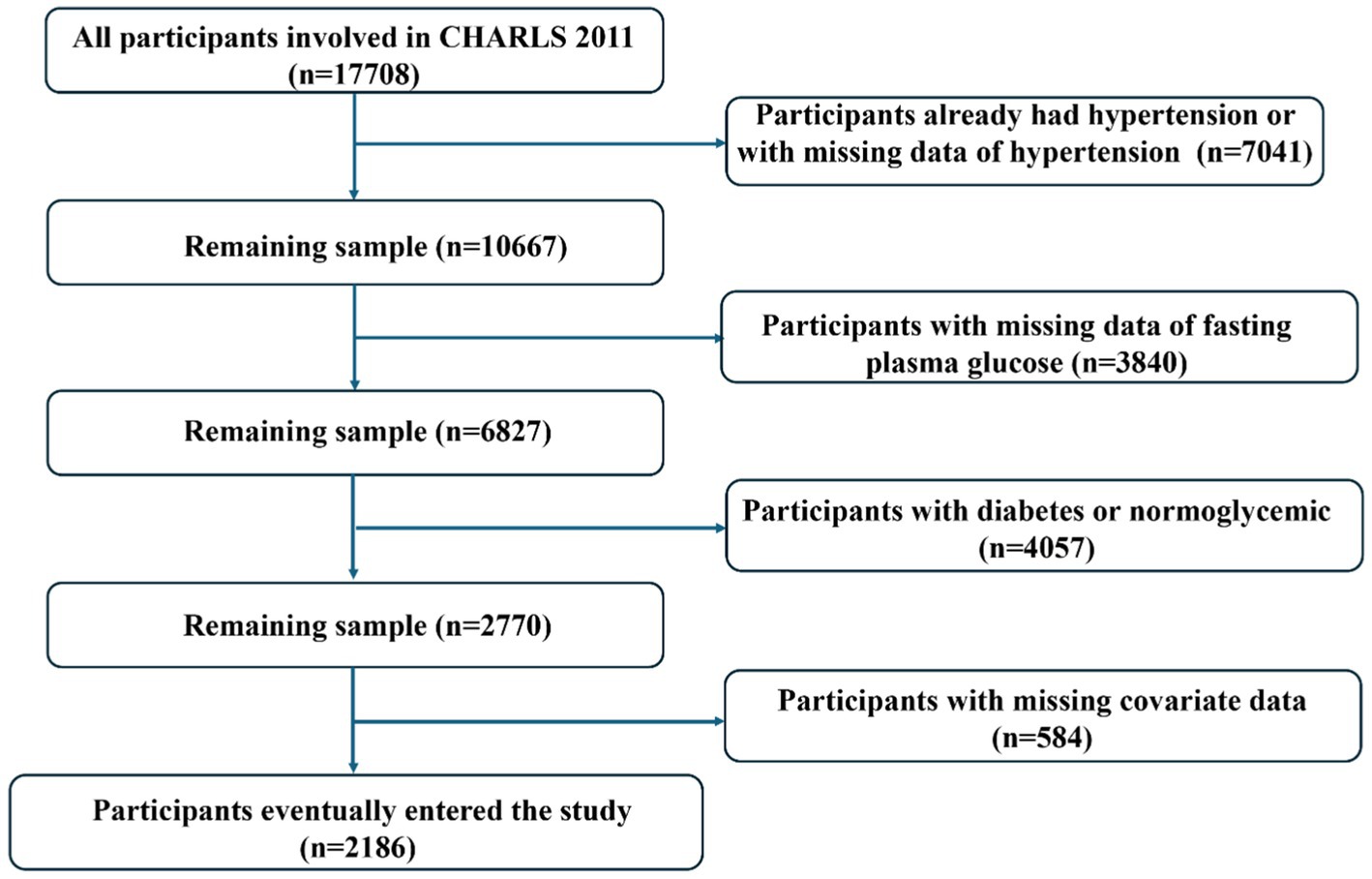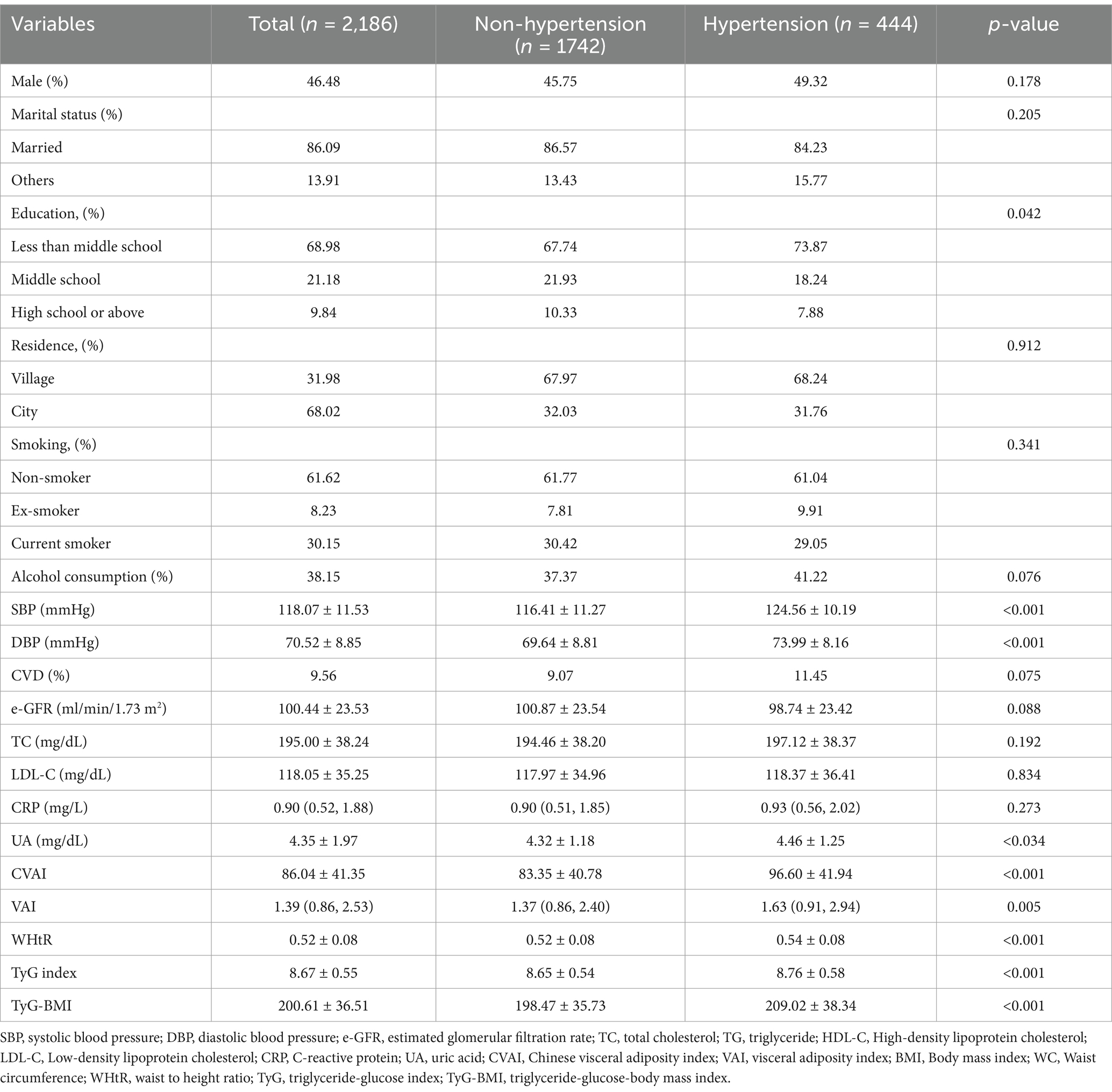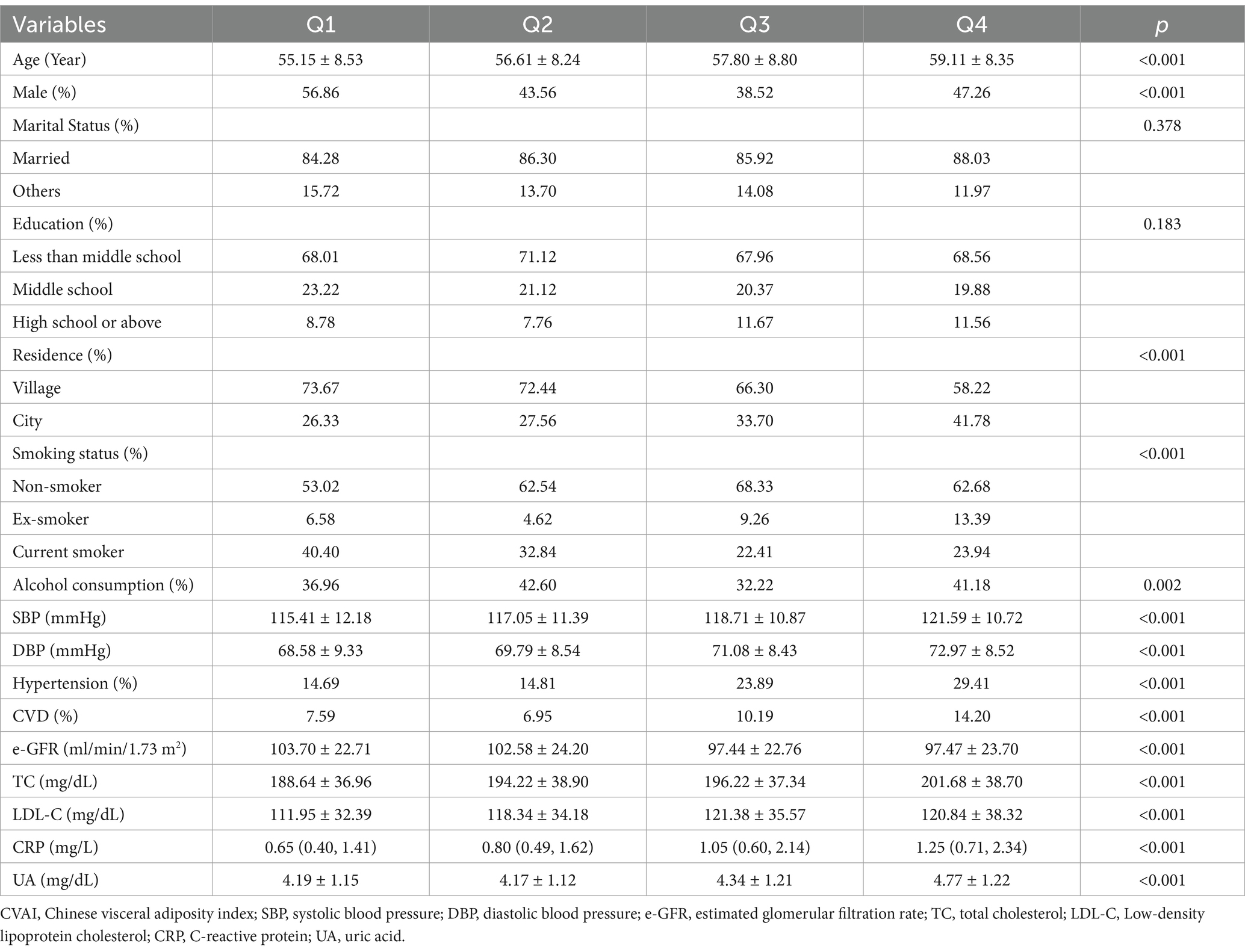- 1Department of Nephrology, Hospital of Xinjiang Production and Construction Corps, Urumqi, Xinjiang, China
- 2Department of Nephrology, Second Affiliated Hospital, Medical School of Shihezi University, Urumqi, Xinjiang, China
- 3Department of Cardiac Pacing and Electrophysiology, The First Affiliated Hospital of Xinjiang Medical University, Urumqi, China
- 4Department of Cardiology, The Sixth Affiliated Hospital of Jinan University (Dongguan Eastern Central Hospital), Dong Guan, Guangdong, China
Purpose: Chinese Visceral Adiposity Index (CVAI) has been found significantly associated with hypertension in general and type-2 diabetes adults. However, the predictive value of CVAI for the incidence of hypertension in adults with prediabetes is unclear. This study aimed to assess the predictive utility of the CVAI for the new onset of hypertension in middle-aged and older adult Chinese individuals with prediabetes.
Methods: A prospective cohort study was conducted involving participants aged 45 years and above with prediabetes from the 2011–2012 cohort of the China Health and Retirement Longitudinal Study (CHARLS). Logistic regression models were utilized to investigate the association between CVAI levels and the risk of new-onset hypertension.
Results: The study included 2,186 participants, among whom 444 (20.31%) developed hypertension. Significantly higher incidence rates of hypertension were observed in individuals belonging to the highest quartile group (Q4) compared to those in the lowest quartile group (Q1) of CVAI (29.41% vs. 14.69%, p < 0.001). Multivariate logistic regression analysis indicated that participants in Q4 had a 1.91-fold greater risk of hypertension development compared to those in Q1 (odds ratio (OR): 1.91, 95% confidence interval (CI): 1.49–2.45, p < 0.001). The area under the receiver operating characteristic (ROC) curve (AUC) demonstrated that CVAI exhibited superior performance in discriminating individuals at heightened risk of hypertension compared to other obesity-related indices (p < 0.001). A subgroup analysis revealed that age may modulate the relationship between CVAI and new-onset hypertension, with a more pronounced interaction observed among participants below 60 years of age (P for interaction: 0.026).
Conclusion: Elevated CVAI levels were significantly associated with an increased risk of developing hypertension. CVAI proves to be a reliable and effective tool for risk stratification in middle-aged and older adult Chinese individuals with prediabetes, underscoring its substantial implications for primary prevention of hypertension and public health strategies.
Introduction
Hypertension, characterized by consistently elevated blood pressure (BP) levels, stands as a primary risk factor for cardiovascular disease (CVD) and mortality in middle-aged and older adult individuals (1, 2). A nationwide survey conducted in China in 2012 revealed that approximately 23.2% of adults were afflicted with hypertension (3), with estimates suggesting this prevalence could reach up to half among individuals aged 35–75 years (4). The aging demographic has witnessed a notable surge in cases of hypertension, with projections indicating that by 2025, roughly one-third of the global population will grapple with hypertension (5). Despite its pervasive presence in China, the rates of awareness, drug therapy, and effective control of hypertension remain suboptimal, necessitating urgent attention toward early and precise identification of risk factors to preemptively thwart its onset and alleviate the associated burden.
Recent studies have emphasized the importance of prediabetes, characterized by consistently elevated blood glucose levels below the diabetic threshold, in increasing the risk of developing type-2 diabetes and CVD (6, 7). Specifically, a cohort study conducted by Yue et al. (8) in Northeast China, which recruited adults aged 40 and above, demonstrated that individuals in this age group with both hypertension and prediabetes faced a significantly higher risk of CVD mortality compared to those with prediabetes alone. Therefore, identifying individuals with prediabetes who are at a heightened risk of progressing to hypertension is of paramount importance.
Obesity, typified by excessive fat accumulation, has emerged as a strong correlation of hypertension development (9, 10). Amidst China’s rapid economic growth in recent decades, the prevalence of overweight and obesity has surged among adults and adolescents, posing substantial challenges to public health systems (11). Studies have highlighted the association between elevated BP and excessive visceral adipose tissues (VAT), particularly over subcutaneous or total fat (12, 13). However, accurately gauging VAT in large-scale studies poses challenges due to factors like radiation exposure risks, time constraints, and the prohibitive costs linked with gold standard methods such as computed tomography (CT) or magnetic resonance imaging (MRI). Conventional anthropometric measures like body mass index (BMI) and waist circumference (WC) fall short in precisely assessing abdominal fat distribution.
Originally devised based on Caucasian populations, the visceral adiposity index (VAI) has emerged as a dependable proxy for evaluating VAT dysfunction and is significantly tied to an escalated risk of hypertension in Western populations (14, 15). Nevertheless, the utility of VAI in appraising VAT has been found wanting in Asian subjects owing to differing body fat distribution characteristics. The Chinese visceral adiposity index (CVAI), a novel all-encompassing surrogate VAT index tailored for Chinese adults, integrates demographic factors (age), anthropometric metrics (BMI and WC), and lipid profiles (serum triglyceride (TG) and high-density lipoprotein (HDL)) (16). CVAI has exhibited strong alignment with CT validation outcomes and has been linked to a markedly increased risk of CVD (17), hypertension (18), and diabetes (19).
The question remains as to whether CVAI exhibits a positive association with the risk of new-onset hypertension in middle-aged and older adult populations with prediabetes. This study seeks to explore the prospective predictive value of CVAI for new-onset hypertension and assess its efficacy relative to other obesity and insulin resistance-related indices (including triglyceride-glucose index (TyG), TyG-BMI, WC to height ratio (WHtR), BMI and WC) using data from the China Health and Retirement Longitudinal Study (CHARLS).
Methods
Study design and participants
This is a prospective cohort study that utilizes data sourced from CHARLS, a nationally representative longitudinal survey overseen by the National School of Development at Peking University and funded by the US National Institute on Aging (NIA). The study targeted community residents aged 45 and above in China. Data collection involved computer-assisted personal interviews (CAPI) and structured questionnaires to capture a comprehensive range of health and retirement-related factors from the participants. The study was initiated in 2011, with subsequent follow-ups conducted biennially. To date, data from three waves (Wave 2: 2013, Wave 3: 2015, and Wave 4: 2018) have been made publicly accessible on the website http://charls.pku.edu.cn/. However, Wave 4 data was not utilized in this study due to lacking information on anti-hypertensive medication usage and BP tests.
Participants were excluded from the study if they met any of the following criteria: (1) with hypertension at baseline; (2) inadequate follow-up data on hypertension, including physician diagnosis, use of anti-hypertensive medications, and BP tests; (3) mortality during the follow-up period; (4) missing baseline covariate data; or (5) existing diabetes or normoglycemia at baseline (Figure 1). The survey received approval from the Ethics Review Board of Peking University, and all participants provided written informed consent.
Definition
Hypertension was defined based on the presence of any of the following criteria: self-reported physician diagnosis of hypertension, recent use of antihypertensive medication, or systolic BP (SBP) ≥140 mm Hg and/or diastolic BP (DBP) ≥90 mm Hg (1).
Prediabetes was characterized by fasting plasma glucose (FPG) levels between 100 and 125 mg/dL or glycosylated hemoglobin A1c (HbA1c) levels between 5.7 and 6.4%. Diabetes was identified by FPG levels ≥125 mg/dL, HbA1c levels ≥6.5%, self-reported history of diabetes, or usage of antidiabetic medications (20).
Measurements
CVAI
−267.93 + 0.68 × age (years) + 0.03 × BMI (kg/m2) + 4.00 × WC (cm) + 22.00 × log10 (TG) (mmol/L) – 16.32 × HDL-C (mmol/L) (Male).
−187.32 + 1.71 × age (years) + 4.23 × BMI (kg/m2) + 1.12 × WC (cm) + 39.76 × log10 (TG) (mmol/L) – 11.66 × HDL-C (mmol/L) (Female).
VAI
WC (cm) / (39.68 + 1.88 × BMI) × TG (mmol/L)/1.03 × 1.31/HDL-C (mmol/L) (Male).
WC (cm) / (36.58 + 1.889 × BMI) × TG (mmol/L)/0.81 × 1.52/HDL-C (mmol/L) (Male).
TyG: Ln [fasting triglycerides (mg/dl) × fasting glucose (mg/dL)/2].
TyG-BMI: Ln [fasting triglycerides (mg/dl) × fasting glucose (mg/dL)/2] × BMI.
WHtR: WC (cm)/ height (cm).
Covariates data collection
The study gathered sociodemographic and lifestyle data, including age, gender, education levels, marital status, smoking status, and alcohol consumption. Laboratory tests encompassed total cholesterol (TC), low-density lipoprotein (LDL), TG, HDL, uric acid (UA), blood creatine, and C-reactive protein (CRP). Estimated glomerular filtration rate (eGFR) was computed using a specific formula: 186 × (creatine)−1.154 × (age)−0.203 × 0.742 (if female). Additionally, chronic diseases such as CVD (self-reported heart disease or stroke) and hyperlipidemia (self-reported or taking lipid-lowering agents or TC ≥ 240 mg/dL or LDL ≥ 160 mg/dL or TG ≥ 200 mg/dL or HDL < 40 mg/dL) were recorded.
Statistical analysis
In this study, individuals were categorized into four subgroups based on quartiles of the CVAI: Q1 (CVAI≤61.46), Q2 (61.46 < CVAI≤85.81), Q3 (85.81 < CVAI≤110.89), and Q4 (CVAI>110.89). Continuous variables were represented as mean ± standard deviation (SD) or median (interquartile range IQR), dependent on the data distribution, and tested using t-tests or Mann–Whitney U tests between the two groups as appropriate. One-way ANOVA or Kruskal–Wallis tests were used among the four groups. Categorical data were presented as percentages (%) and analyzed using Chi-square tests.
Three logistic regression models were developed to assess the odds ratio (OR) and 95% confidence interval (CI) for new-onset hypertension in relation to CVAI, examining both its continuous impact (per IQR increment) and its categorical effect across quartiles. Model I was unadjusted; Model II was adjusted for gender, education levels, marital status, residential location, smoking status, and alcohol consumption; Model III included additional adjustments for CVD, hyperlipidemia, CRP, LDL, TC, and e-GFR.
To explore the nonlinear association and dose–response relationship between CVAI and new-onset hypertension, a restricted cubic spline (RCS) analysis was conducted that incorporated 4 knots at 5th, 35th and 65th and 95th percentiles of CVAI. Subgroup analyses, stratifying by age, gender, education levels, smoking status, and CVD, were performed to evaluate the robustness of the association across different populations. Interaction analyses were also carried out to identify potential moderating effects among these factors.
Receiver operating characteristic (ROC) curves were utilized to assess the diagnostic utility of CVAI for predicting new-onset hypertension among individuals with prediabetes. Furthermore, a Z-test was employed to compare the diagnostic accuracy of CVAI against other indices related to obesity and insulin resistance in predicting new-onset hypertension.
Statistical analyses were conducted using STATA (version 14.0) and R studio (version 4.0.3), with a significance threshold set at p < 0.05 to determine statistical significance. All figures in this study were drawn using GraphPad Prism 8.0.
Results
Baseline characteristics of participants
A total of 2,186 participants were ultimately included in this study, with hypertension developing in 444 individuals (20.31%). The baseline characteristics of the participants are detailed in Table 1 and Figure 2. Among those with prediabetes, 1,016 (46.48%) were males, with an average age of 57.10 ± 8.59 years. Individuals who developed hypertension tended to be older, obese, less educated, and exhibited higher levels of SBP, DBP, TG and UA and lower level of HDL compared to those who did not develop hypertension.

Figure 2. Comparison of the data from the CVAI formulas between those with hypertension and without hypertension. *p < 0.05, **p < 0.01, ***p < 0.001.
Baseline characteristics of participants based on the quartiles of CVAI
Table 2 presents the baseline characteristics of the participants categorized into quartiles based on CVAI. Individuals with higher CVAI levels were generally older, predominantly female, residing in urban areas, and had a history of cardiovascular disease. They had a lower prevalence of smoking, but higher alcohol consumption. Furthermore, they exhibited elevated levels of SBP, DBP, LDL-C, CRP, UA, and a lower e-GFR. Notably, there was a significant increase in the incidence of hypertension as CVAI quartiles rose (Q1: 14.69% vs. Q2: 14.81% vs. Q3: 23.89% vs. Q4: 29.41% p < 0.001).
Association between CVAI and new-onset hypertension
Table 3 illustrated that per 1-IQR increase in CVAI was significantly linked to a 26% higher risk of developing hypertension among middle-aged and older adults with prediabetes (OR: 1.26, 95% CI: 1.16–1.36). Furthermore, participants in the third (Q3) and fourth (Q4) quartiles of CVAI faced a 37% (OR: 1.37, 95% CI: 1.07–1.75) and a 91% (OR: 1.91, 95% CI: 1.49–2.45) increased the risk of developing hypertension, respectively, compared to those in the first quartile (Q1). Multivariable adjusted restricted cubic spline analyses revealed a significant linear dose–response relationship between CVAI and new-onset hypertension (P for overall: <0.001, P non-linear:0.175) (Figure 3).
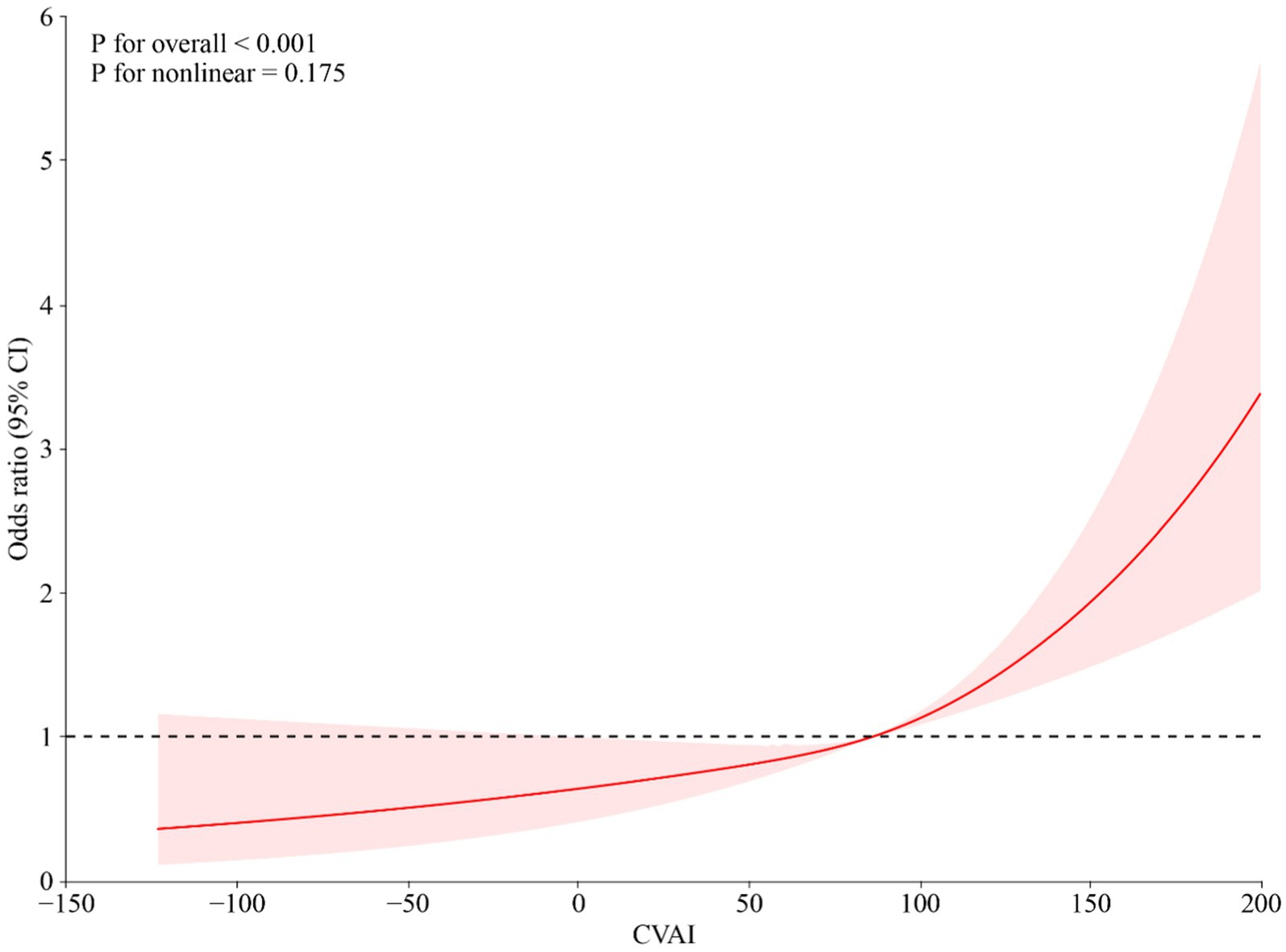
Figure 3. Restricted cubic spline for the incidence of hypertension by CVAI after adjusting for confounding factors.
Subgroup analysis
Subgroup analyses were conducted to explore the association between CVAI and new-onset hypertension in various populations. As illustrated in Figure 4, age significantly modified the relationship between CVAI and new-onset hypertension among Chinese middle-aged and older adults with prediabetes (interaction p = 0.026). This indicated that CVAI was associated with a higher risk of new-onset hypertension among younger participants (≥60 years vs. <60 years: OR: 1.25, 95% CI: 1.07–1.47 vs. OR: 1.46, 95% CI: 1.27–1.67).
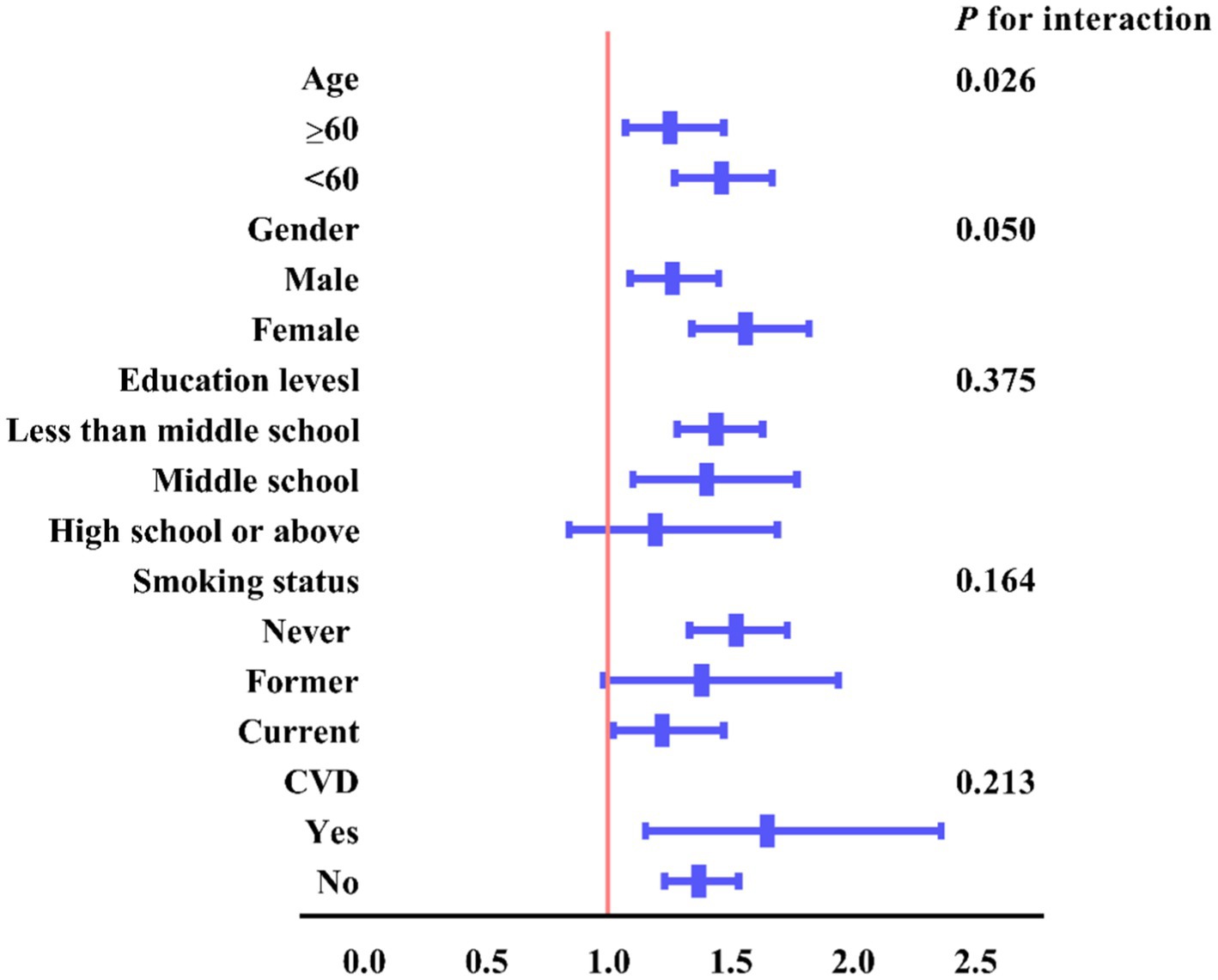
Figure 4. Subgroup and interaction analyses between the CVAI (per 1.0-SD increment) and hypertension across various subgroups.
Predictive value of CVAI and other obesity and insulin-resistance indices for the new-onset hypertension
The study also assessed the predictive capacity of CVAI and other indices for new-onset hypertension by constructing ROC curves. As shown in Figure 5, CVAI demonstrated superior predictive value for new-onset hypertension compared to other indices (area under curve (AUC) p < 0.05).
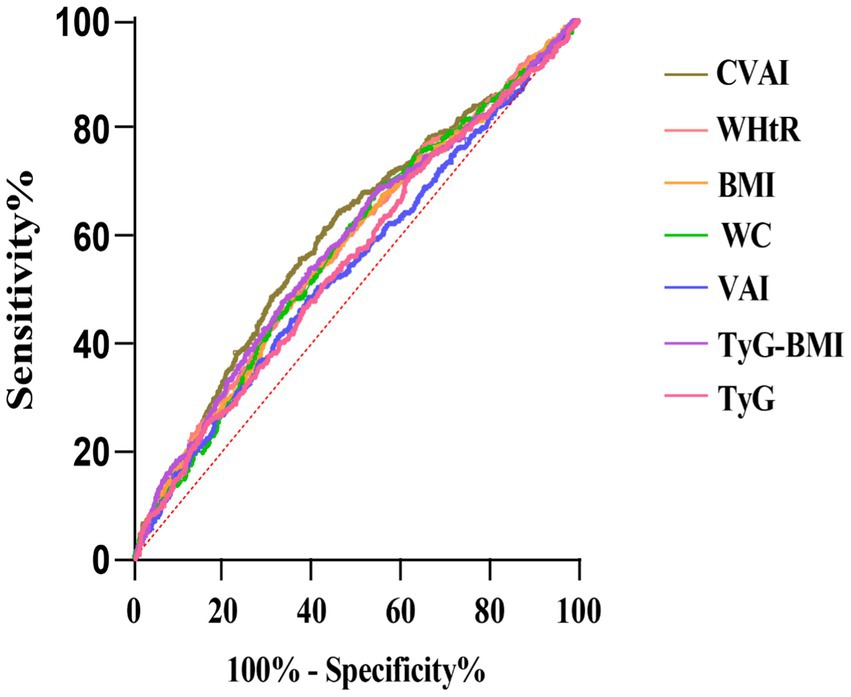
Figure 5. Receiver operating characteristic curves of obesity and lipids related indices in predicting hypertension.
Discussion
To the best of our knowledge, this study is the first to investigate the predictive value of CVAI for the development of hypertension in middle-aged and older Chinese individuals with prediabetes. The main findings of this study are as follows: (1) Participants with higher CVAI levels had a significantly increased risk of developing hypertension, even after adjusting for potential confounding factors. (2) There was a linear dose–response relationship between CVAI and the incidence of hypertension. (3) CVAI demonstrated superior predictive ability for new-onset hypertension compared to other indices related to obesity and insulin resistance.
Currently, there exists inconsistency in the diagnostic criteria for prediabetes. The World Health Organization (WHO) defines prediabetes as FPG levels between 6.1 mmol/L and 6.9 mmol/L (110-125 mg/dL) (21). On the other hand, the American Diabetes Association (ADA) recommends a lower cutoff value for FPG (5.6–6.9 mmol/L or 100–125 mg/dL) or hemoglobin A1c (HbA1c) levels of 5.7–6.4% to diagnose prediabetes (20). In this study, we adopted the ADA criteria for prediabetes diagnosis, as previous studies have shown that individuals diagnosed with prediabetes according to ADA criteria have a significantly increased risk of CVD, cardiovascular events, and mortality.
Prediabetes represents a significant risk factor for the development of diabetes, with approximately 5–10% of individuals with prediabetes progressing to diabetes within 1 year, which is significantly higher than the general population’s annual progression rate of around 3.5% (22). In our study, we observed a higher prevalence of prediabetes in rural populations compared to urban individuals (68.02% vs. 31.98%, p < 0.001), which is consistent with a previous cohort study conducted in Northeast China (8).
With the rapid economic and technological development in recent years, obesity, particularly abdominal obesity, has become a significant public health burden in China. An epidemiological study reported an overall obesity rate of 15.76% (BMI ≥28.0 kg/m2 for both women and men) and an abdominal obesity rate of 38.65% (WC ≥ 85 cm for women or WC ≥90 cm for men) among middle-aged and older Chinese individuals (23). Visceral obesity, characterized by excessive VAT accumulation, has been found to be strongly associated with an increased risk of cardiovascular disease compared to overall obesity. While WC indeed provides some insights into visceral obesity, its ability to distinguish between subcutaneous and visceral fat levels is limited (24). VAI, initially developed by Amato et al. (14) in Western populations, has been found to be significantly associated with an increased risk of metabolic syndrome (MetS) components, cardiovascular and cerebrovascular events, making it a valuable indicator for assessing visceral obesity function and insulin sensitivity. However, it’s important to note that there are notable variations in body fat percentage and distribution across different racial groups. Asians, in particular, exhibit higher body fat percentage at lower BMI compared to Caucasians and are more prone to accumulating visceral fat (25). Therefore, CVAI, a more comprehensive index, integrating age, HDL, LDL, BMI, and WC, was developed specifically for Chinese populations. In a prospective cohort study involving rural Chinese adults, elevated CVAI levels at baseline and over time were found to be significantly associated with an increased risk of developing hypertension in both males and females. Furthermore, CVAI demonstrated superior predictive capabilities for hypertension compared to other indices of visceral obesity in both genders (26). Cheng et.al (27) also found that CVAI had the best discriminative value for hypertension in patients with type-2 diabetes compared to other abdominal obesity-related indices. Consistent with these findings, our study also revealed a significant association between elevated CVAI levels and an increased risk of developing hypertension in middle-aged and older Chinese individuals with prediabetes. Additionally, CVAI outperformed other obesity and lipid-related indices in identifying individuals at higher risk for developing hypertension.
The detailed mechanisms linking visceral obesity to the development of hypertension in individuals with prediabetes are still not fully understood and warrant further investigation. However, potential explanations include: (1) Upregulated activity of the renin-angiotensin aldosterone system (RAAS) induced by adipose tissue, which may significantly contribute to the development of hypertension in adults with prediabetes. The local RAAS plays a crucial role in adipocyte differentiation and triglyceride modulation (28). Adipocytes secrete Angiotensin II type 2 receptors, which promote the proliferation of mature, insulin-sensitive adipocytes and the differentiation of preadipocytes (29). A prediabetes animal model induced by a high-fat, high-carbohydrate diet showed significantly increased expression of renin, angiotensinogen (AGT), and angiotensin II type 1 receptor (AT1R) in adipose tissue, and importantly, all components of RAAS were significantly increased in the heart in the prediabetes group (30). (2) Insulin resistance, a common pathophysiological process in the development of prediabetes and diabetes, significantly contributes to the pathogenesis of hypertension through various mechanisms in adults with prediabetes, including endothelial dysfunction, sodium retention, heightened sympathetic activity, and vascular hypertrophy (31, 32). An animal study using aged mice found that decreased accumulation of visceral fat was associated with alleviated insulin resistance (33). In our study, we also observed a significant positive correlation between CVAI and TyG-BMI, a well-established surrogate marker of insulin resistance (Pearson analysis: r = 0.70, p < 0.001).
Limitations
Several limitations should be acknowledged in this study. Firstly, although we observed a significant association between CVAI and the onset of hypertension, the nature of observational study precludes us from establishing a causal relationship. Secondly, the study participants were exclusively Chinese, and therefore, the generalizability of the findings to other ethnic populations, particularly Western adults, warrants further investigation. Thirdly, in this study, we only included adults aged 45 years or older, which restricts the generalizability of our findings to younger populations. Future research should consider including a broader age range of Chinese individuals to assess potential age-related differences in the outcomes. Additionally, the reliance on self-reported data during interviews for the diagnosis of hypertension and diabetes introduces the potential for recall bias. Finally, the recruitment of participants aged 45 and above may limit the broader applicability of the findings, necessitating further large-scale studies involving the general population.
Conclusion
In this study, we found that increased baseline CVAI was positively associated with the risk of developing hypertension, and CVAI may applied as a useful tool for risk stratification of the hypertension incidence in middle-aged and older Chinese adults with a prediabetes stage.
Data availability statement
The raw data supporting the conclusions of this article will be made available by the authors, without undue reservation.
Ethics statement
This study was based on publicly available datasets (CHARLS). Ethical review and approval was not required for the study on human participants in accordance with the local legislation and institutional requirements. Written informed consent from the patients/participants or patients/participants legal guardian/next of kin was not required to participate in this study in accordance with the national legislation and the institutional requirements. For CHARLS, the Institutional Review Board of Peking University approved the study, and informed consent was obtained from all participants.
Author contributions
LL: Writing – original draft. LX: Formal analysis, Writing – original draft. QW: Writing – review & editing.
Funding
The author(s) declare that no financial support was received for the research, authorship, and/or publication of this article.
Acknowledgments
The authors express gratitude to the CHARLS research team and all individuals who participated in the study.
Conflict of interest
The authors declare that the research was conducted in the absence of any commercial or financial relationships that could be construed as a potential conflict of interest.
Generative AI statement
The authors declare that no Gen AI was used in the creation of this manuscript.
Publisher’s note
All claims expressed in this article are solely those of the authors and do not necessarily represent those of their affiliated organizations, or those of the publisher, the editors and the reviewers. Any product that may be evaluated in this article, or claim that may be made by its manufacturer, is not guaranteed or endorsed by the publisher.
References
1. Williams, B, Mancia, G, Spiering, W, Agabiti Rosei, E, Azizi, M, Burnier, M, et al. Group ESCSD: 2018 ESC/ESH guidelines for the management of arterial hypertension. Eur Heart J. (2018) 39:3021–104. doi: 10.1093/eurheartj/ehy339
2. Messerli, FH, Rimoldi, SF, and Bangalore, S. The transition from hypertension to heart failure: contemporary update. JACC Heart failure. (2017) 5:543–51. doi: 10.1016/j.jchf.2017.04.012
3. Wang, Z, Chen, Z, Zhang, L, Wang, X, Hao, G, Zhang, Z, et al. Status of hypertension in China: results from the China hypertension survey, 2012-2015. Circulation. (2018) 137:2344–56. doi: 10.1161/circulationaha.117.032380
4. Lu, J, Lu, Y, Wang, X, Li, X, Linderman, GC, Wu, C, et al. Prevalence, awareness, treatment, and control of hypertension in China: data from 1·7 million adults in a population-based screening study (China PEACE million persons project). Lancet. (2017) 390:2549–58. doi: 10.1016/s0140-6736(17)32478-9
5. NCD Risk Factor Collaboration (NCD-RisC). Worldwide trends in hypertension prevalence and progress in treatment and control from 1990 to 2019: a pooled analysis of 1201 population-representative studies with 104 million participants. Lancet. (2021) 398:957–80. doi: 10.1016/s0140-6736(21)01330-1
6. Huang, Y, Cai, X, Mai, W, Li, M, and Hu, Y. Association between prediabetes and risk of cardiovascular disease and all cause mortality: systematic review and meta-analysis. BMJ. (2016) 355:i5953. doi: 10.1136/bmj.i5953
8. Yue, L, Tian, Y, Ma, M, Jing, L, Sun, Q, Shi, L, et al. Prevalence of prediabetes and risk of CVD mortality in individuals with prediabetes alone or plus hypertension in Northeast China: insight from a population based cohort study. BMC Public Health. (2024) 24:475. doi: 10.1186/s12889-024-17996-y
9. Dhawan, D, and Sharma, S. Abdominal obesity, adipokines and non-communicable diseases. J Steroid Biochem Mol Biol. (2020) 203:105737. doi: 10.1016/j.jsbmb.2020.105737
10. Boustany, CM, Bharadwaj, K, Daugherty, A, Brown, DR, Randall, DC, and Cassis, LA. Activation of the systemic and adipose renin-angiotensin system in rats with diet-induced obesity and hypertension. Am J Physiol Regul Integr Comp Physiol. (2004) 287:R943–9. doi: 10.1152/ajpregu.00265.2004
11. Pan, XF, Wang, L, and Pan, A. Epidemiology and determinants of obesity in China. Lancet Diabetes Endocrinol. (2021) 9:373–92. doi: 10.1016/s2213-8587(21)00045-0
12. Deng, WW, Wang, J, Liu, MM, Wang, D, Zhao, Y, Liu, YQ, et al. Body mass index compared with abdominal obesity indicators in relation to prehypertension and hypertension in adults: the CHPSNE study. Am J Hypertens. (2012) 26:58–67. doi: 10.1093/ajh/hps001
13. Chandra, A, Neeland, IJ, Berry, JD, Ayers, CR, Rohatgi, A, Das, SR, et al. The relationship of body mass and fat distribution with incident hypertension. J Am Coll Cardiol. (2014) 64:997–1002. doi: 10.1016/j.jacc.2014.05.057
14. Amato, MC, Giordano, C, Galia, M, Criscimanna, A, Vitabile, S, Midiri, M, et al. Visceral adiposity index: a reliable indicator of visceral fat function associated with cardiometabolic risk. Diabetes Care. (2010) 33:920–2. doi: 10.2337/dc09-1825
15. Zhang, Y, He, Q, Zhang, W, Xiong, Y, Shen, S, Yang, J, et al. Non-linear associations between visceral adiposity index and cardiovascular and cerebrovascular diseases: results from the NHANES (1999–2018). Front Cardiovasc Med. (2022) 9:908020. doi: 10.3389/fcvm.2022.908020
16. Wu, J, Gong, L, Li, Q, Hu, J, Zhang, S, Wang, Y, et al. A novel visceral adiposity index for prediction of type 2 diabetes and pre-diabetes in Chinese adults: a 5-year prospective study. Sci Rep. (2017) 7:7. doi: 10.1038/s41598-017-14251-w
17. Zhang, Z, Zhao, L, Lu, Y, Meng, X, and Zhou, X. Association between Chinese visceral adiposity index and risk of stroke incidence in middle-aged and elderly Chinese population: evidence from a large national cohort study. J Transl Med. (2023) 21:518. doi: 10.1186/s12967-023-04309-x
18. Gui, J, Li, Y, Liu, H, Guo, L-l, Li, J, Lei, Y, et al. Obesity-and lipid-related indices as a risk factor of hypertension in mid-aged and elderly Chinese: a cross-sectional study. BMC Geriatr. (2024) 24:77. doi: 10.1186/s12877-023-04650-2
19. Shang, L, Li, R, Zhao, Y, Sun, H, Tang, B, and Hou, Y. Association between Chinese visceral adiposity index and incident type 2 diabetes mellitus in Japanese adults. Diabetes Metab Syndr Obes. (2021) 14:3743–51. doi: 10.2147/dmso.S322935
20. American Diabetes Association. Standards of medical care in diabetes--2013. Diabetes Care. (2013) 36, Suppl 1:S11–66. doi: 10.2337/dc13-S011
21. Colagiuri, S. Definition and classification of diabetes and prediabetes and emerging data on phenotypes. Endocrinol Metab Clin N Am. (2021) 50:319–36. doi: 10.1016/j.ecl.2021.06.004
22. Adler, AI, Shine, BSF, Chamnan, P, Haworth, CS, and Bilton, D. Genetic determinants and epidemiology of cystic fibrosis-related diabetes: results from a British cohort of children and adults. Diabetes Care. (2008) 31:1789–94. doi: 10.2337/dc08-0466
23. Mu, L, Liu, J, Zhou, G, Wu, C, Chen, B, Lu, Y, et al. Obesity prevalence and risks among Chinese adults: findings from the China PEACE million persons project, 2014–2018. Circ Cardiovasc Qual Outcomes. (2021) 14:e007292. doi: 10.1161/circoutcomes.120.007292
24. Ross, R, Neeland, IJ, Yamashita, S, Shai, I, Seidell, J, Magni, P, et al. Waist circumference as a vital sign in clinical practice: a consensus statement from the IAS and ICCR working group on visceral obesity. Nat Rev Endocrinol. (2020) 16:177–89. doi: 10.1038/s41574-019-0310-7
25. Deurenberg, P, Deurenberg-Yap, M, and Guricci, S. Asians are different from Caucasians and from each other in their body mass index/body fat per cent relationship. Obes Rev. (2002) 3:141–6. doi: 10.1046/j.1467-789x.2002.00065.x
26. Han, M, Qie, R, Li, Q, Liu, L, Huang, S, Wu, X, et al. Chinese visceral adiposity index, a novel indicator of visceral obesity for assessing the risk of incident hypertension in a prospective cohort study. Br J Nutr. (2020) 126:612–20. doi: 10.1017/s0007114520004298
27. Cheng, C, Yu, X, Shi, K, Dai, G, Pan, Q, Yuan, G, et al. Associations between abdominal obesity indices with hypertension in type 2 diabetes mellitus: Chinese visceral adiposity index. J Endocrinol Investig. (2023) 47:547–55. doi: 10.1007/s40618-023-02165-6
28. Cooper, ME. The role of the renin-angiotensin-aldosterone system in diabetes and its vascular complications. Am J Hypertens. (2004) 17:S16–20. doi: 10.1016/j.amjhyper.2004.08.004
29. Than, A, Xu, S, Li, R, Leow, MK, Sun, L, and Chen, P. Angiotensin type 2 receptor activation promotes browning of white adipose tissue and brown adipogenesis. Signal Transduct Target Ther. (2017) 2:17022. doi: 10.1038/sigtrans.2017.22
30. Mkhize, BC, Mosili, P, Ngubane, PS, Sibiya, NH, and Khathi, A. Diet-induced prediabetes: effects on the activity of the renin–angiotensin–aldosterone system in selected organs. J Diabetes Investig. (2022) 13:768–80. doi: 10.1111/jdi.13690
31. Zhai, Y, Fu, H, Li, Y, Li, S, Zhang, W, Yue, J, et al. Relationship between four insulin resistance surrogates and left ventricular hypertrophy among hypertensive adults: a case-control study. Endocr Connect. (2024). 13:e230476. doi: 10.1530/ec-23-0476
32. Santra, S, Basu, AK, Roychowdhury, P, Banerjee, R, Singhania, P, Singh, S, et al. Comparison of left ventricular mass in normotensive type 2 diabetes mellitus patients with that in the nondiabetic population. J Cardiovasc Dis Res. (2011) 2:50–6. doi: 10.4103/0975-3583.78597
Keywords: prediabetes, hypertension, obesity, Chinese visceral adiposity index, biomarker
Citation: Li L, Xi L and Wang Q (2025) Association between Chinese visceral adiposity index and risk of new-onset hypertension in middle-aged and older adults with prediabetes: evidence from a large national cohort study. Front. Public Health. 13:1509898. doi: 10.3389/fpubh.2025.1509898
Edited by:
Di Yang, Fudan University, ChinaReviewed by:
Luis Del Carpio-Orantes, Mexican Social Security Institute, MexicoGuevara-Balcázar Gustavo, National Polytechnic Institute (IPN), Mexico
Copyright © 2025 Li, Xi and Wang. This is an open-access article distributed under the terms of the Creative Commons Attribution License (CC BY). The use, distribution or reproduction in other forums is permitted, provided the original author(s) and the copyright owner(s) are credited and that the original publication in this journal is cited, in accordance with accepted academic practice. No use, distribution or reproduction is permitted which does not comply with these terms.
*Correspondence: Qianhui Wang, MTc4MTIwOTAxNjBAMTYzLmNvbQ==
‡Present Address: Linqiang Xi, The Sixth Affiliated Hospital of Jinan University (Dongguan Eastern Central Hospital), Changping, Dongguan, Guangdong Province, China
†These authors have contributed equally to this work and share first authorship
 Lanlan Li
Lanlan Li Linqiang Xi
Linqiang Xi Qianhui Wang
Qianhui Wang